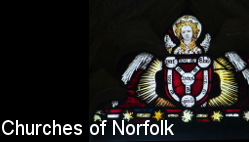
home I index I latest I glossary I introductions I e-mail I about this site
Beeston
Priory, Beeston Regis
'St Mary in
the Meadow'
Follow these journeys as they happen at Last Of England Twitter.
| Beeston
Priory, Beeston Regis This impressive ruin sits tucked attractively away by the fields behind a farmhouse just off of the busy Sheringham to Cromer road, from which it is signposted. It is the surprisingly complete remains of a small Augustinian priory founded in the early 13th Century. The priory was unusual for such a small foundation because it was independent, one of several such in Norfolk, and Gunter Endres, in his majestic series of books Power & Piety, tells us that it probably never consisted of more than the prior and four canons. He notes that the priory was founded by the family of Margery de Cressy, and that the original endowment of lands, rents, meadows, wreck of sea and fisheries were added to later by Lucy, Abbess of Caen. However, as with many small foundations it fell on hard times after the pestilences of the mid-14th Century, and Pope Boniface IV sanctioned the appropriation of West Runton church to supplement its income. The ruin is popularly known as St Mary in the Meadow, and it is open every day. You enter through the west doorway, stabilised in recent years with a red brick dressing. The west window above must be later than the chancel by perhaps a century, and so this end of the church was perhaps all remodelled at that time. You pass beneath it into a long aisleless nave with the chancel beyond. A large north transept leads into a chapel on the north side of the chancel, and also has a doorway leading back westwards into the sacristy. There's a smaller south transept which led to the chapter house and the cloisters, which are now under the garden of the farmhouse. Of course, all of this would originally have been faced in limestone, the great bulk of which has long since been harvested for other purposes, and what we are seeing is the flint rubble core. And yet it is a satisfyingly easy building to read. The 13th Century arcading on the south side of the chancel with its two blocked windows drops to the setting for the piscina and sedilia, both now gone but still recognisable in shape. No trace remains of the central tower other than the doorway in its south-west corner into the tower stairs, a few steps of which survive. They would also have led to the rood loft. The priory stumbled along in its own quiet way through the centuries, rarely making its mark on the events of the day. Gunter Endres records that the Valor Ecclesiasticus of 1535 assessed its annual income at just £43, which is less than £50,000 in today's money, out of which they had to dispense alms and hospitality to strangers as well as providing clergy to the local churches. It seems that the Priory managed to escape the closure of the smaller foundations the following year because, it is said, 'they pretended themselves to be friars'. The Priory likely pledged its allegiance to Henry VIII as the head of the new Church of England, but as with other priories that did this, it did not save them and the foundation was dissolved in August 1539. Looking out over the meadows to the north of the ruin, across the stew ponds that provided fish for the community during Lent, you can't help thinking that the scene cannot have changed very much from that summer day when the prior and his small community set out from their home for the very last time. Simon Knott, May 2023 Follow these journeys as they happen at Last Of England Twitter. |
|
|||||||||||||||||||||||||||||||||||||||||||||||||||||||
home I index I latest I introductions I e-mail I about this site I glossary
links I small
print I www.simonknott.co.uk I www.suffolkchurches.co.uk
ruined churches I desktop backgrounds I round tower churches